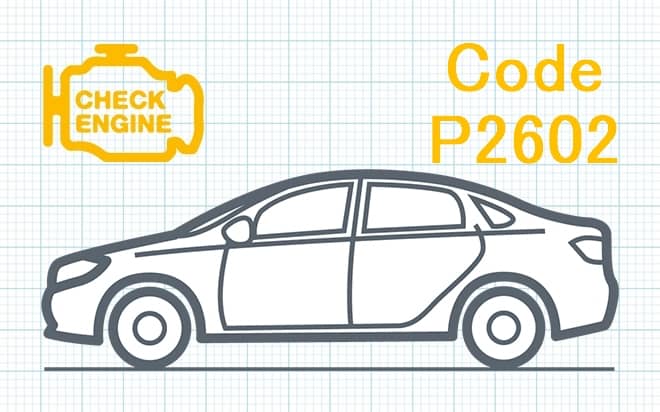
P2602 Coolant pump control circuit low
Content
P2602 Coolant pump control circuit low
Home »Codes P2602-P2699» P2602
OBD-II DTC Datasheet
Low signal in the coolant pump control circuit "A"
What does this mean?
This Generic Transmission / Engine DTC usually applies to all OBDII equipped engines with electric coolant pumps, but is more common in some Ford, Honda, Nissan, and Toyota hybrids.
Coolant pump A (CP-A) can usually be found mounted at the front of the engine, on top of the engine, inside the wheel arches, or opposite a bulkhead. CP-A is controlled by an electrical signal from the powertrain control module (PCM).
The PCM receives input to determine when and how long it needs to operate with the CP-A. These inputs are voltage signals received from the coolant temperature, intake air temperature, engine speed, and air conditioning pressure sensors. Once the PCM receives this input, it can change the signal to CP-A.
P2602 is usually installed due to electrical problems (CP-A circuit). They should not be overlooked during the troubleshooting phase, especially when solving an intermittent problem.
Troubleshooting steps may vary depending on the manufacturer, CP-A type and wire colors.
Corresponding Coolant Pump A Circuit Fault Codes:
- P2600 Coolant pump "A" Open control circuit
- P2601 Coolant Pump "A" Performance Range
- P2603 Coolant Pump "A" Control Circuit High
Symptoms and severity
The severity is usually very severe due to the impact on the cooling system. Since this is usually an electrical problem, the PCM cannot fully compensate for it. Partial compensation usually means the cooling fans are running all the time (100% duty cycle).
Symptoms of a P2602 code may include:
- Fault indicator light is on
- overheating
- The air conditioning system is not working properly
reasons
Possible reasons for setting this code:
- Open circuit to coolant pump - probably
- Faulty coolant pump - probably
- Failed PCM – Unlikely
Diagnostic and repair procedures
A good starting point is always to check the Technical Service Bulletins (TSB) for your particular vehicle. Your problem may be a known issue with a known manufacturer-released fix and could save you time and money while troubleshooting.
Then find the coolant pump B (CP-A) on your specific vehicle. This pump is usually installed at the front of the engine, on top of the engine, inside the wheel arches, or opposite a bulkhead. Once found, visually inspect the connector and wiring. Look for scratches, scuffs, exposed wires, burn marks, or molten plastic. Disconnect the connector and carefully inspect the terminals (metal parts) inside the connector. See if they look burnt or have a green tint indicating corrosion. If you need to clean the terminals, use an electrical contact cleaner and a plastic bristle brush. Allow to dry and apply electrical grease where the terminals touch.
If you have a scan tool, clear the DTCs from memory and see if P2602 returns. If this is not the case, then there is most likely a connection problem.
For this particular code, this is the most common area of concern, as are relays/connections to relays, with pump failure coming in second.
If the code returns, we will need to test the pump and associated circuits. Usually there are 2 wires on each coolant pump. Disconnect the harness going to the coolant pump first. Using a digital volt ohmmeter (DVOM), connect one lead of the meter to one terminal on the pump. Connect the remaining meter lead to the other terminal on the pump. It must not be open-circuited or short-circuited. Check the resistance characteristics for your specific vehicle. If the pump motor is open or shorted (infinite resistance or no resistance / 0 ohms), replace the coolant pump.
If this test passes, with the DVOM make sure you have 12V on the coolant pump power circuit (red wire to pump power circuit, black wire to good ground). With a scan tool that can activate the coolant pump, turn on the coolant pump. If the pump does not have 12 volts, repair the wiring from the PCM or relay to the pump, or possibly a faulty PCM.
If everything is in order, check that the coolant pump is properly grounded. Connect a test lamp to the 12 V battery positive (red terminal) and touch the other end of the test lamp to the ground circuit that leads to the coolant pump circuit ground. Using the scan tool to operate the coolant pump, check to see if the test lamp illuminates each time the scan tool drives the pump. If the test lamp does not light up, it indicates a faulty circuit. If it does light up, wiggle the harness going to the pump to see if the test light blinks, indicating an intermittent connection.
If all of the previous tests passed and you continue to receive P2602, it will most likely indicate a failed coolant pump, although a failed PCM cannot be ruled out until the coolant pump is replaced. If you are unsure, seek help from a qualified automotive diagnostician. To install correctly, the PCM must be programmed or calibrated for the vehicle.
Similar codes for other coolant pumps include P261A, P261B, P261C, and P261D.
Related DTC discussions
- There are currently no related topics in our forums. Post a new topic on the forum now.
Need more help with your p2602 code?
If you still need help with DTC P2602, post a question in the comments below this article.
NOTE. This information is provided for informational purposes only. It is not intended to be used as a repair recommendation and we are not responsible for any action you take on any vehicle. All information on this site is protected by copyright.
